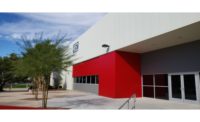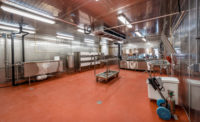Metal Panels Chosen for Massive New Alaska Airlines Hangar




The saying “go big or go home” is a perfect fit for a recent Kingspan Insulated Metal Panel division project in Alaska; the company supplied more than 72,000 square feet of insulated metal panels for a new Alaska Airlines maintenance and engineering facility in Anchorage.
The new $50 million state-of-the-art, two-bay hangar is twice the size of the old facility, which dates back to the 1950’s. The 110,000 square-foot facility was built to house two Boeing 737-Max aircraft, the largest in Alaska Airlines’ fleet.
“Our existing facility served us well for many years. But as we grow and add larger planes to our fleet, the time was right for us to upgrade our northernmost maintenance facility,” said Kurt Kinder, former Alaska Airlines vice president of maintenance and engineering, on the company’s website.
The new hangar was designed by the Anchorage office of MCG Architecture. The project was completed in November of 2018 – on schedule and on budget.
MCG chose Kingspan KS Micro-Rib panels for the new hangar.
“Important factors in choosing metal panels for this project were schedule, speed, durability, efficiency and the one-shot envelope,” said Jason Gamache, principal architect and director of sustainability for MCG.
Construction speed was an important consideration, due to Alaska’s shortened construction season; earthwork generally stops in October and doesn’t begin again until March or April. The speed of construction that insulated metal panels (IMPs) provide eliminated the need to do temporary enclosure, which would have needed to be heated. Inside trades were also dependent on being able to close the building.
“Once we got the product on site it was very easy to install the panels and almost instantly have a building enclosure,” said Gamache. “Any work inside the building, like painting or concrete work that are temperature-sensitive, are schedule-dependent on us being able to close the building.”
Using IMPs on a building this large also helped keep costs down by reducing the number of trades needed during construction, as well as reducing layers of operation. Immediately after installation, it was a finished assembly both inside and out.
“Having one product shipped from the supplier to Alaska, picked up at the port, delivered on site and then installed and finished is a huge benefit to a project in terms of schedule and managing construction costs - particularly in terms of labor,” said Gamache.
The designers specified large panels for the massive hangar – 34 feet long and four feet wide, using 24 gauge steel. Kingspan’s KS Micro-Rib panel’s corrugated structure helps prevent “oil canning,” an important factor for panels of that size. The panels were installed by Kiewit.
Another consideration in choosing IMPs for the new hangar was energy efficiency, as code in Anchorage requires continuous insulation. A four-inch panel was used and there is no other additional insulation.
“One of the challenges with hangars or any kind of shop is that a large portion of your building is an opening,” said Gamache. “In this case, we have a giant 286-foot-wide by 47-foot-tall door that is a giant puncture in your envelope.”
The continuous insulation and high R-values that IMPs provide, along with the energy systems in the building, prevent a constant battle with that necessary hole in the side of the building. There’s the obvious need to keep the indoor space warm during the winter, but not too warm when crews are working on the aircraft. The hangar doors raise instead of slide in order to capture heat.
"As you raise the doors, you want to capture the heat in the ceiling," Alaska Airline’s Kinder told a local TV station. "The beauty of this new building is we have these new air handling units that take that captured heat; as soon as you close the door, it takes that heat and puts it down on the ground where you're working again. Literally within minutes, you can go from 24 degrees to 65 degrees."
Sustainability was another goal that insulated metal panels helped with, as the building went through the LEED precertification process. Using a single product for cladding and insulation reduces a tremendous amount of waste.
“When we use drywall to finish the interior of a building, 15-percent of that ends up as waste – that’s material that was paid for and is going straight into the dump, and then you pay again for dump fees,” said Gamache.
Being able to pre-design and engineer a product like insulated metal panels reduces a tremendous amount of waste. For the new Alaska Airlines hangar, metal panel scraps were even used to create a parapet for the parking structure for the facility and ended up looking like it was part of the original design.
The U.S. Environmental Protection Agency promotes a Sustainable Materials Management approach to reduce life-cycle material use, energy use and waste production. While reuse and recycling are important methods to sustainably manage waste that has been generated, source reduction prevents waste from being generated in the first place.
Looking for a reprint of this article?
From high-res PDFs to custom plaques, order your copy today!







